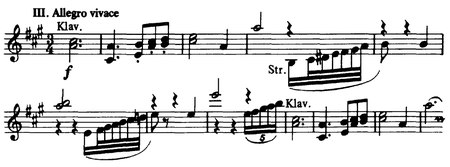I. Allegro affettuoso
The main movement of the concerto is marked Allegro affettuoso; its origin lay in the one-movement fantasy written by Schumann in 1841, at whose core is the musical development of the conflict between the boisterous Florestan and the dreamy Eusebius, two characters Schumann often used to express the duality of being. The movement is set in 4/4 rhythm.

The piece starts with an energetic strike by strings and timpani, followed by a fierce, descending attack by the piano. This exposition chord is followed by a descending, rhythmically incisive chord progression of the solo piano corresponding to the ideal of the boisterous Florestan.
Only then, the main, dreamlike theme of Eusebius is introduced by the oboe along with other wind instruments. The melody begins with the notes C–H–A–A, which stand for the Italian spelling of the first name CHiArA of Schumann's wife Clara, who was the soloist at the world premiere of the piano concerto. After its introduction by the woodwinds, the theme is then given to the soloist. Schumann provides great variety with this theme.
In the course of the first movement Schumann varies this theme in many ways. He first offers it in the A minor key of the movement, then we hear it again in major, and we can also hear small snatches of the tune in a very slow, A-flat section. The orchestra and especially the clarinet is often used against the piano in this movement: while the solo instrument is dedicated to the main theme of the concerto, the strings begin to intone a Florestan-like, syncopated side thought (bar 41), which becomes more and more dominant, until a variation of the Eusebian main theme recurs quietly but urgently.
This is followed by a subsection labeled Animato. At its end Schumann introduces a second theme, which does not reach the significance of the main theme.
Subsequently, the development of the main movement begins in the form of a dramatic lament (bar 156). This part almost reaches the position of an independent middle section. In A-flat major, the metrically altered main theme is referenced by piano arpeggios. Suddenly, however, chords of the Florestan theme interrupt the peace of the main theme. It comes to a struggle between the two ideals, which shapes the development further with rapid changes of soli and tutti.
With further dramatic progression and the modulation to A minor, the reprise is finally reached and cites the exposition almost tone for tone. The last tense progression brings forth a solo cadenza of monumental size and virtuosity (bar 402). It is undoubtedly the culmination of the movement.
In the coda, a throbbing, mysterious 2/4 rhythm dominates. This is turned into a fierce Davidsbündler-march a little later. The main movement of the concerto ends with four tutti chords.




